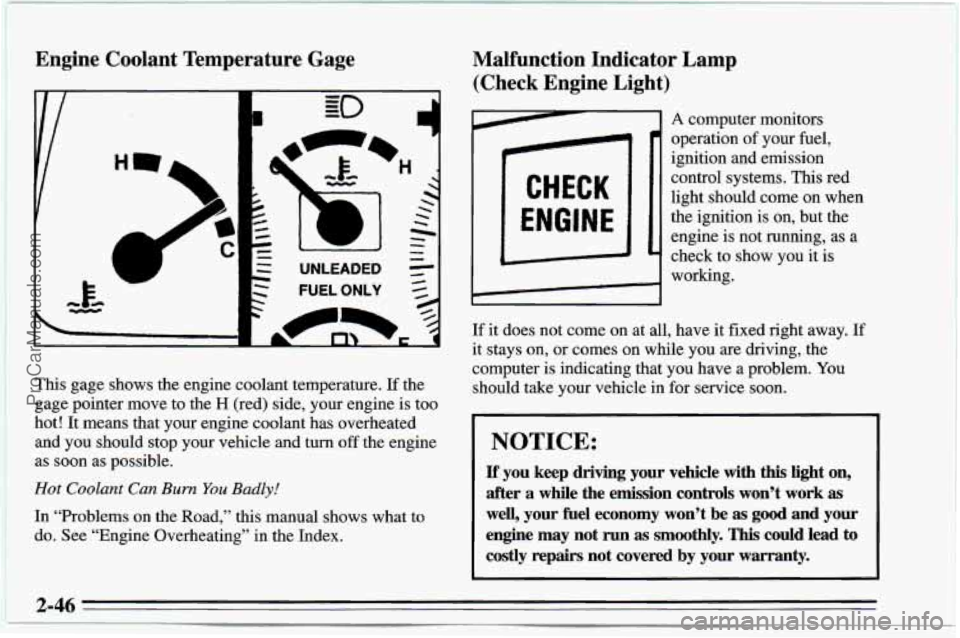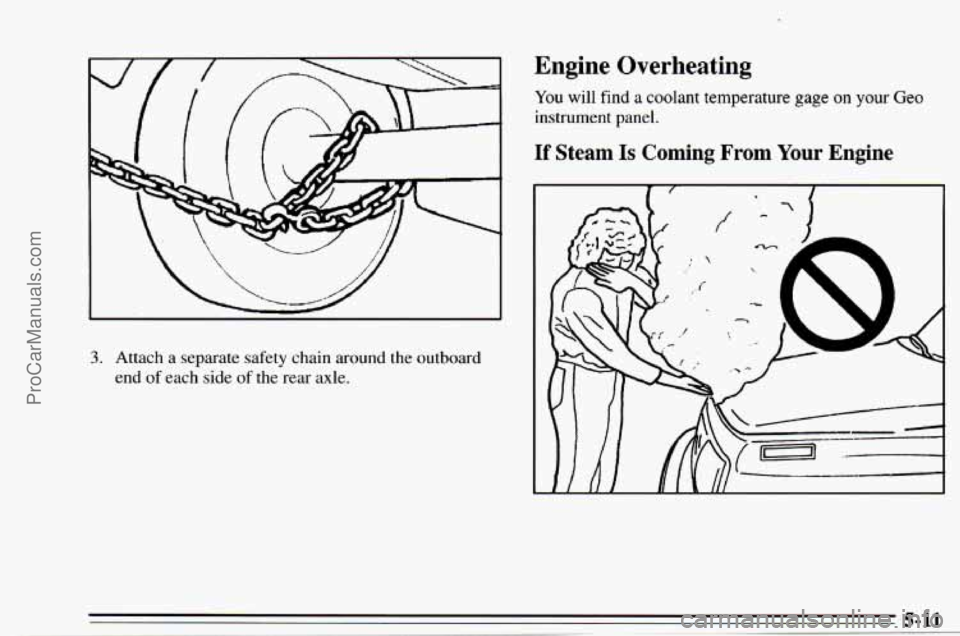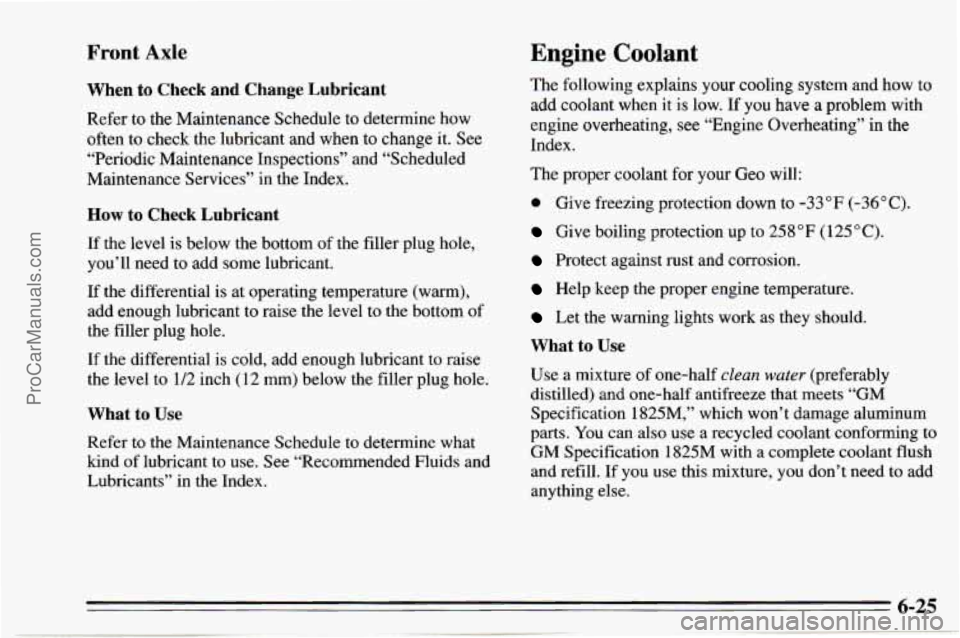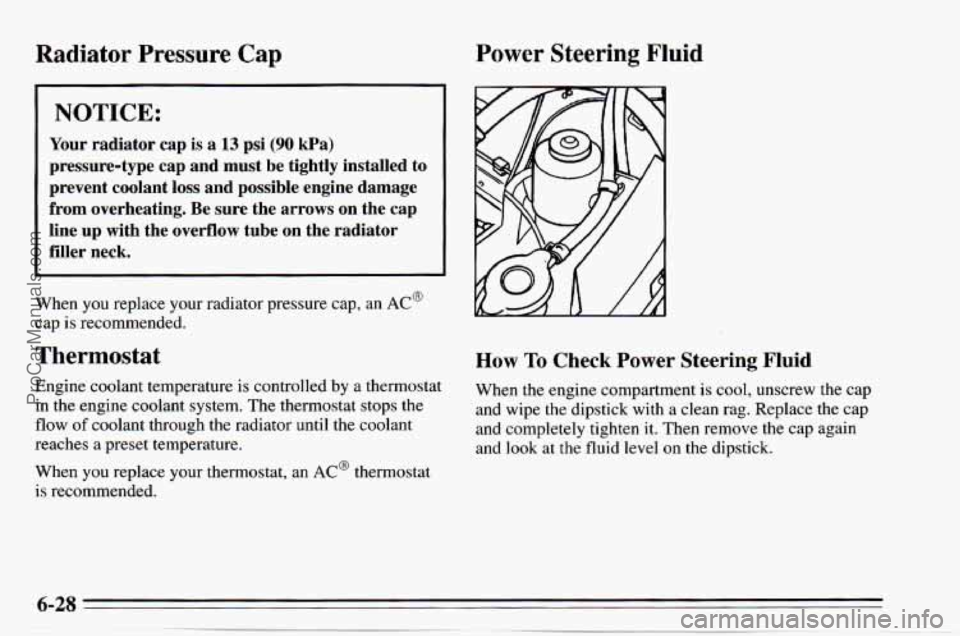coolant temperature CHEVROLET TRACKER 1995 Owners Manual
[x] Cancel search | Manufacturer: CHEVROLET, Model Year: 1995, Model line: TRACKER, Model: CHEVROLET TRACKER 1995Pages: 354, PDF Size: 18.24 MB
Page 89 of 354

Engine Coolant Temperature Gage
This gage shows the engine coolant temperature. If the
gage pointer move to the
H (red) side, your engine is too
hot! It means that your engine coolant has overheated
and you should stop your vehicle and turn
off the engine
as soon as possible.
Hot Coolant Can Burn You Badly!
In “Problems on the Road,” this manual shows what to
do. See “Engine Overheating”
in the Index.
Malfunction Indicator Lamp
(Check Engine Light)
A computer monitors
operation
of your fuel,
ignition and emission
control systems. This red
light should come
on when
the ignition
is on, but the
engine
is not running, as a
check to show you it is
CHECK
ENGINE
Da i
I
If it does not come on at all, have it fixed right away. If
it stays on, or comes on while you are driving, the
computer is indicating that you have a problem. You
should take your vehicle in
for service soon.
NOTICE:
If’ you keep driving your vehicle with this light on,
after a while the emission controls won’t work
as
well, your fuel economy won’t be as good and your
engine may not
run as smoothly. This could lead to
costly repairs not covered by your warranty.
2-46
I
ProCarManuals.com
Page 188 of 354

c
3. Attach a separate safety chain around the outboard
end
of each side of the rear axle.
Engine Overheating
You will find a coolant temperature gage on your Geo
instrument panel.
If Steam Is Coming From Your Engine
ProCarManuals.com
Page 236 of 354

Front Axle Engine Coolant
When to Check and Change Lubricant
Refer to the Maintenance Schedule to determine how
often to check the lubricant and when to change it. See
“Periodic Maintenance Inspections” and “Scheduled
Maintenance Services” in the Index.
How to Check Lubricant
If the level is below the bottom of the filler plug hole,
you’ll need to add some lubricant.
If the differential is at operating temperature (warm),
add enough lubricant to raise the level to the bottom of
the filler plug hole.
If the differential is cold, add enough lubricant to raise
the level to 1/2 inch (12 mm) below the filler plug hole.
What to Use
Refer to the Maintenance Schedule to determine what
kind of lubricant to use. See “Recommended Fluids and
Lubricants” in the Index. The following explains
your cooling
system and how to
add coolant when it is low. If you have a problem with
engine overheating, see “Engine Overheating’’ in the
Index.
The proper coolant for your Geo will:
0 Give freezing protection down to -33°F (-36°C).
Give boiling protection up to 258°F (125°C).
Protect against rust and corrosion.
Help keep the proper engine temperature.
Let the warning lights work as they should.
What to Use
Use a mixture of one-half clean water (preferably
distilled) and one-half antifreeze that meets
“GM
Specification 1825M,” which won’t damage aluminum
parts. You can also use a recycled coolant conforming to
GM Specification 1825M with a complete coolant flush
and refill. If you use this mixture, you don’t need to add
anything else.
ProCarManuals.com
Page 239 of 354

Radiator Pressure Cap Power Steering Fluid
I NOTICE:
Your radiator cap is a 13 psi (90 kPa)
pressure-type cap and must be tightly installed to
prevent coolant
loss and possible engine damage
from overheating. Be sure the arrows on the cap
line up with the overflow tube on the radiator
filler neck.
When you replace your radiator pressure cap, an AC@
cap is recommended.
Thermostat
Engine coolant temperature is controlled by a thermostat
in the engine coolant system. The thermostat stops the
flow of coolant through the radiator until the coolant
reaches
a preset temperature.
When
you replace your thermostat, an AC@ thermostat
is recommended.
How To Check Power Steering Fluid
When the engine compartment is cool, unscrew the cap
and wipe the dipstick with a clean rag. Replace the cap
and completely tighten it. Then remove the cap again
and look at the
fluid level on the dipstick.
ProCarManuals.com
Page 347 of 354

Easy-Entry Seat ................................ I -4
Electrical Equipment. Adding
................ 2-10. 6-59
Enginecoolant
................................. 6-25
Adding
.................................... 6-26
Checking
................................... 6-26
Temperature Gage
............................ 2-46
Exhaust
.................................... 2-25
Identification
................................ 6-59
Overheating
................................. 5- 1 1
Running it While You’re Parked ................. 2-25
Specifications
............................... 6-64
Starting
..................................... 2-9
16-Valve
................................... 6-10
8-Valve
..................................... 6-8
Engineoil
.................................... 6-12
Adding
.................................... 6-13
Additives
................................... 6-15
Checking ................................... 6-12
Pressure Light
............................... 2-47
What Kind to Use
............................ 6- 14
What to do with Used Oil
...................... 6- I6
Whentochange
............................. 6-15
Ethanol(InFue1)
................................ 6-3
Exhaust. Engine
................................ 2-25
Expectant Mothers. Use
of Safety Belts ............. 1-20
Extender. Safety Belt ............................ 1-34
Fabric Cleaning
............................... 6-50
Fan Control Lever ............................... 3-2
Feature. Theft-Deterrent
.................... 3- 10. 3- 15
Fifth (5). Manual Transmission .................... 2- 15
FillingYourTank ................................ 6-4
Engine
Filter. Air Cleaner
.............................. 6-18
Finish Care
.................................... 6-54
Finish Damage
................................. 6-56
First
(1). Manual Transmission .................... 2-14
Flashers. Hazard Warning
......................... 5-1
Flat Tire. Changing
............................. 5-21
Flow-Through Ventilation System
................... 3-4
Fluid Capacities Chart ........................... 6-65
Flushing. Underbody
............................ 7-51
Folding Rear Seat
................................ 1-5
Foreign Countries. Fuel
........................... 6-4
Four-wheel Drive
......................... 2-17. 6-24
Fourth (4). Manual Transmission
................... 2-15
Freewheeling
Hubs ............................. 2-17
FrenchLanguage Manual
11
Front Ashtray .................................. 2-36
FrontAxle
.................................... 6-25
Front Parking and Turn Signal. Replacement
......... 6-37
Front Seat Side Pockets
........................... 2-6
Front Towing Hook-Ups
.......................... 5-8
Fuel
.......................................... 6-2
Gage
...................................... 2-48
Fuse Block. Instrument Panel
..................... 6-42
Fuse Block. Main
............................... 6-62
Fuseusage
.................................... 6-62
Fuses and Circuit Breakers
....................... 6-60
Gage
.. ...........................
FillingYourTank ............................. 6-4
In Foreign Countries
........................... 6-4
Engine Coolant Temperature
................... 2-46
Fuel
....................................... 2-48
Gasolines for Cleaner Air
......................... 6-3
9-4
-.-- .- _____ ..... .... --.-_Y_I____N___W___l~~=,,ll--C. ~~ ~ ProCarManuals.com